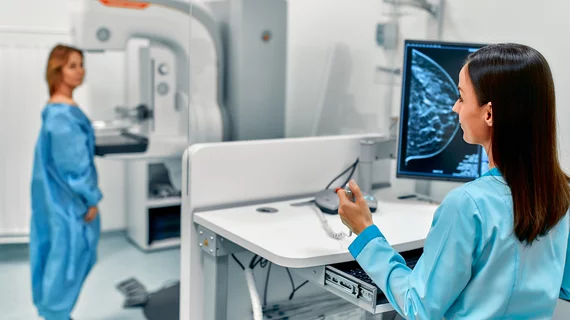FDA issues guidance to help imaging providers comply with new mammography requirements
The U.S. Food and Drug Administration issued new guidance Friday to assist small imaging providers in complying with forthcoming mammography requirements.
Beginning next month, breast imaging facilities will be required to notify patients about the density of their breasts, among other changes. About half of women over 40 face this issue, which can increase cancer risk and make detection more difficult.
The FDA first issued the regulatory update early last year. In addition, the administration also is enhancing its enforcement capabilities over breast imaging facilities and modernizing mammography regulations by incorporating current science and industry best practices.
“Today the U.S. Food and Drug Administration issued a Small Entity Compliance Guide to assist small entities, including mammography facilities, in complying with the FDA’s March 2023 final rule,” the FDA said in an email sent Friday. “The amendments, which become effective September 10, 2024, will help modernize the regulations by incorporating current science and mammography best practices.”
The administration said the new guidance is aimed at helping small imaging providers to understand the updates in plain language, including:
- The scope of the 2023 Mammography Quality Standards Act Rule.
- How facilities should communicate with patients and share mammogram results.
- Requirements for reporting breast density.
- Recommendations on how radiology facilities should comply with the act.
Facilities that fail to become accredited after three consecutive attempts must wait one year from the date of the rejection before applying again to any accrediting body. Beginning with the Sept. 10 changes, imaging facilities must provide each patient with a written summary of their results. The communication must be written in lay terms patients can easily understand, including a final assessment of the findings, tissue density and any recommendations made to other providers.
“For patients who do not name a healthcare provider to receive the mammography report, the patient must be sent the more technical mammography report within 30 days of the exam,” the guidance document notes. “If the assessment of the mammography report is ‘suspicious’ or ‘highly suggestive of malignancy,’ the facility must send the mammography report and lay summary to the patient within seven calendar days of the final interpretation of the exam.”
Radiology providers also must have a system for referring patients to a healthcare provider when clinically indicated. This includes instances when mammography results are “probably benign,” “suspicious” or “highly suggestive of malignancy.” The FDA also will require providers to maintain the original mammograms and related reports in a permanent medical record for a period of not less than five years (and longer with some caveats).
There is no explicit requirement for formatting a mammography report, the FDA noted. However, next month they will require elements including two overall assessments (of the findings and breast density). Both should be placed in a way that is “distinct and identifiable.” Facilities also are required to establish a system to collect and review outcome data for all exams performed. In such audits, providers must correlate the pathology results with the mammography report and (as of September 10) include at least three metrics—positive predictive value, cancer detection rate and recall rate. They also must retain such audit data until the MQSA annual inspection following the facility’s analysis of this information.
There’s lots more information in the 54-page document, which replaces the Policy Guidance Help System beginning on Sept. 10. You can find the full guide here, with it slated to be published in the Federal Register today, Aug. 26.
The American College of Radiology hosted a town hall on the regulation changes earlier this month. You can watch a recording here.

